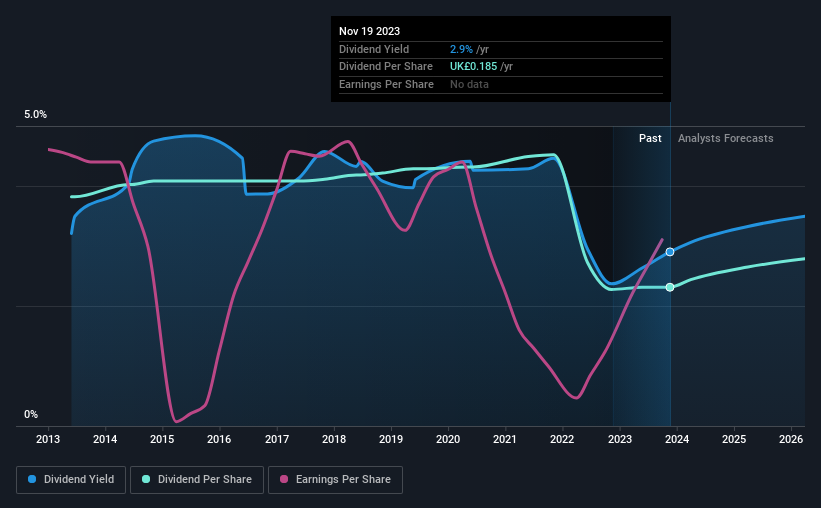Don't Race Out To Buy Tate & Lyle plc (LON:TATE) Just Because It's Going Ex-Dividend
Readers hoping to buy Tate & Lyle plc (LON:TATE) for its dividend will need to make their move shortly, as the stock is about to trade ex-dividend. The ex-dividend date is one business day before the record date, which is the cut-off date for shareholders to be present on the company's books to be eligible for a dividend payment. The ex-dividend date is important because any transaction on a stock needs to have been settled before the record date in order to be eligible for a dividend. Therefore, if you purchase Tate & Lyle's shares on or after the 23rd of November, you won't be eligible to receive the dividend, when it is paid on the 5th of January.
The company's next dividend payment will be UK£0.062 per share. Last year, in total, the company distributed UK£0.18 to shareholders. Based on the last year's worth of payments, Tate & Lyle stock has a trailing yield of around 2.9% on the current share price of £6.375. Dividends are a major contributor to investment returns for long term holders, but only if the dividend continues to be paid. So we need to check whether the dividend payments are covered, and if earnings are growing.
View our latest analysis for Tate & Lyle
If a company pays out more in dividends than it earned, then the dividend might become unsustainable - hardly an ideal situation. Fortunately Tate & Lyle's payout ratio is modest, at just 44% of profit. That said, even highly profitable companies sometimes might not generate enough cash to pay the dividend, which is why we should always check if the dividend is covered by cash flow. Over the last year, it paid out dividends equivalent to 317% of what it generated in free cash flow, a disturbingly high percentage. It's pretty hard to pay out more than you earn, so we wonder how Tate & Lyle intends to continue funding this dividend, or if it could be forced to cut the payment.
Tate & Lyle paid out less in dividends than it reported in profits, but unfortunately it didn't generate enough cash to cover the dividend. Cash is king, as they say, and were Tate & Lyle to repeatedly pay dividends that aren't well covered by cashflow, we would consider this a warning sign.
Click here to see the company's payout ratio, plus analyst estimates of its future dividends.
Have Earnings And Dividends Been Growing?
When earnings decline, dividend companies become much harder to analyse and own safely. If earnings fall far enough, the company could be forced to cut its dividend. Tate & Lyle's earnings per share have fallen at approximately 8.1% a year over the previous five years. Such a sharp decline casts doubt on the future sustainability of the dividend.
Another key way to measure a company's dividend prospects is by measuring its historical rate of dividend growth. Tate & Lyle has seen its dividend decline 4.9% per annum on average over the past 10 years, which is not great to see. It's never nice to see earnings and dividends falling, but at least management has cut the dividend rather than potentially risk the company's health in an attempt to maintain it.
Final Takeaway
Should investors buy Tate & Lyle for the upcoming dividend? It's disappointing to see earnings per share declining, and this would ordinarily be enough to discourage us from most dividend stocks, even though Tate & Lyle is paying out less than half its income as dividends. However, it's also paying out an uncomfortably high percentage of its cash flow, which makes us wonder just how sustainable the dividend really is. It's not that we think Tate & Lyle is a bad company, but these characteristics don't generally lead to outstanding dividend performance.
Although, if you're still interested in Tate & Lyle and want to know more, you'll find it very useful to know what risks this stock faces. Every company has risks, and we've spotted 1 warning sign for Tate & Lyle you should know about.
Generally, we wouldn't recommend just buying the first dividend stock you see. Here's a curated list of interesting stocks that are strong dividend payers.
Have feedback on this article? Concerned about the content? Get in touch with us directly. Alternatively, email editorial-team (at) simplywallst.com.
This article by Simply Wall St is general in nature. We provide commentary based on historical data and analyst forecasts only using an unbiased methodology and our articles are not intended to be financial advice. It does not constitute a recommendation to buy or sell any stock, and does not take account of your objectives, or your financial situation. We aim to bring you long-term focused analysis driven by fundamental data. Note that our analysis may not factor in the latest price-sensitive company announcements or qualitative material. Simply Wall St has no position in any stocks mentioned.

